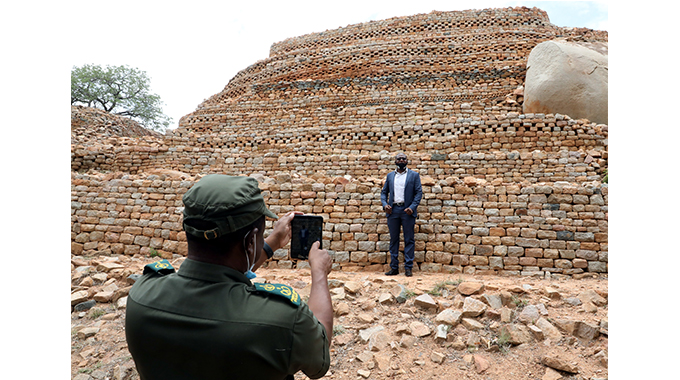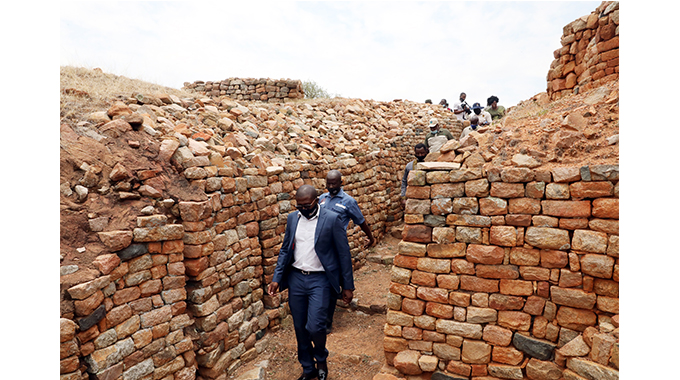
The Sunday News

Bruce Ndlovu, Sunday Life Reporter
“AND I thought I was fit,” Environment, Climate, Tourism and Hospitality Minister Mangaliso Ndlovu said.
As he said so, he drew a lungful of air and sighed. He had just climbed to near the summit of the Khami Ruins. The view from the top was as rewarding as the climb had been punishing. Near the top of the ruins, one gets an impression of how scenic Khami is.
The panoramic view of the vegetation that surrounds the ruins is simply breathtaking. Mopane, marula, combretum and terminalia trees stretch for several kilometres, while thick grass, awakened by the recent rains, dominates on the bush floor.
Hundreds of years after the citizens of this ancient empire piled stone upon stone and built a magnificent empire, the maze of granite that they constructed still stands, unbothered by either time or nature and its sometimes — violent weather.
Khami is the place where time has stood still. Yes, it is a ruin, and the kingdom that it represents is long gone, but the granite structures serves a reminder of indigenous ingenuity and workmanship.
It was clear that Minister Ndlovu, as he climbed to upper levels of the ruins last Saturday morning, was not dressed for the occasion. He looked Ministerial in his immaculate, well-cut blue suit. His shoes looked ready-made for Government halls but they were not a great fit instead of the dry dust of Khami which puffed up into tiny clouds every time he took a step. That dust demanded tougher leather and even more stubborn soles.
Despite this, the Minister knew that he had just travelled through history. It had all started at the foot of the hills, were the tour guide and site manager, Todini Runganga spoke about where this ancient kingdom of stone called Khami had come from.
“The understanding was that Khami was the capital of the state known as the Butua State. It extended to Matobo, Plumtree, Northern Botswana. There are some who say Khami was established by people that moved from the Great Zimbabwe state but recently in the past 10 years archeological evidence suggests that Khami could have developed as a wave of its own . . . which suggests they both co-existed at the same time,” said.
Khami, if historical records are to be believed, rose to prominence around AD1414 although its foundation could have been earlier. At its prime, Khami had 9 000 residents, most of whom lived at the foot of the majestic ruins. During these prime years, it had reportedly interacted and traded with people from Asia and the Far East, who brought gold and porcelain in exchange for the gold Khami’s citizens mined from the Greenstone Belt that runs around Bulawayo.
“We were giving them gold for that?” Minister Ndlovu quizzed. “That doesn’t seem to have been a fair trader,” he added to much laughter.
Before Khami was just the ruins, they were a home of granite to some. So, when did Khami become the shadow of the kingdom it once was?
“As a state the earliest dates of destruction as a state is around 1450 and the collapse itself is estimated to have been around 1640-1650. So, we are talking about a structure that lasted for 200 years,” said Runganga.
At the southern end of the ruins, lies a great boulder on which is engraved a cross. According to Runganga, this is one of the great attractions for tourists, who make a pilgrimage to it seeking good fortune.
“People come here and make a wish and toss a coin and they believe that their lives will change for the better. Last year we had a small clay pot and if you come to this place you will find a lot of currencies. People from all countries and all races come here believing that they can get spiritual guidance. We have both Christians and Non-Christians.
“Someone left one cent?” Minister Ndlovu asked.
“It depends on what you’re wishing for,” another person quipped to much laughter.
As attractive as the cross is to people from all over the world, it is an example of tampering with historical monuments that was prevalent during the colonial era. It was only built in 1938, hundreds of years after the people of Khami’s hands had worked magic with the granite and constructed eye-watering structures that have defied the interference of time.
During that era, the colonial custodians of Khami tried to preserve and fortify the monument with artificial additions like cement. They would reinforce with steel building blocks that threatened to leave the company of others and potentially trigger a collapse. Nowadays, caretakers prefer to use colour coding, a method in which a block that is about to fall away is identified by a few markings. Should it collapse, it is later found and returned to its rightful place. That way, the Khami Ruins are maintained as their builders intended them to be when they built them all those centuries ago.
“This place was under the Historical Monuments Commission, which was run by white people. The way that they were running it from that time up until the late 1970s is different from the way that we are running it now. If you look at the ruins, they would try to repair some damage using cement which at the moment we do not use because we want to keep the authenticity of the place . . . so with that it was easier for them to allow the engraving of the cross but we have a different approach,” said Runganga
The efforts of local archeologists, to preserve the natural state of Khami earned the praise of Minister Ndlovu.

Minister Mangaliso Ndlovu and his family touring Khami Ruins
“It was a lifetime lesson as we were coming through but what touched me the most was the restoration work that was done by our indigenous archeologists who were very careful not to distort any of the original structures. We also did realise that there are some places that need urgent restoration,” he said.
Despite its abundant beauty, only 7 000 people walk through the gates of the Khami Ruins every year. As the country expands its domestic tourism drive, places like Khami are coming under the spotlight. For years, the country has jealously guarded its prime tourism destinations, rightfully marketing them as some of the best in the world. In the era of Covid-19 however, authorities have also begun to realise that many have never in fact seen the beauty that lies in their backyards.
“I believe as a country we have the opportunity to show the world our foundation, what practices we used to do the scenic beauty of these heritage sites. More importantly, it’s just about 20km from Bulawayo (city centre) and I can imagine an excursion in which 10 to 15 minutes you are here having a good time. We want to encourage people when they visit Bulawayo, be it en route elsewhere or actually staying in Bulawayo, to make it a habit to come here.
‘I grew up in Bulawayo myself and I have only been here once. Today is my second time and as I was learning more about this place it was this was my first time. That’s why I want to encourage people to visit more and more,” Minister Ndlovu said.



